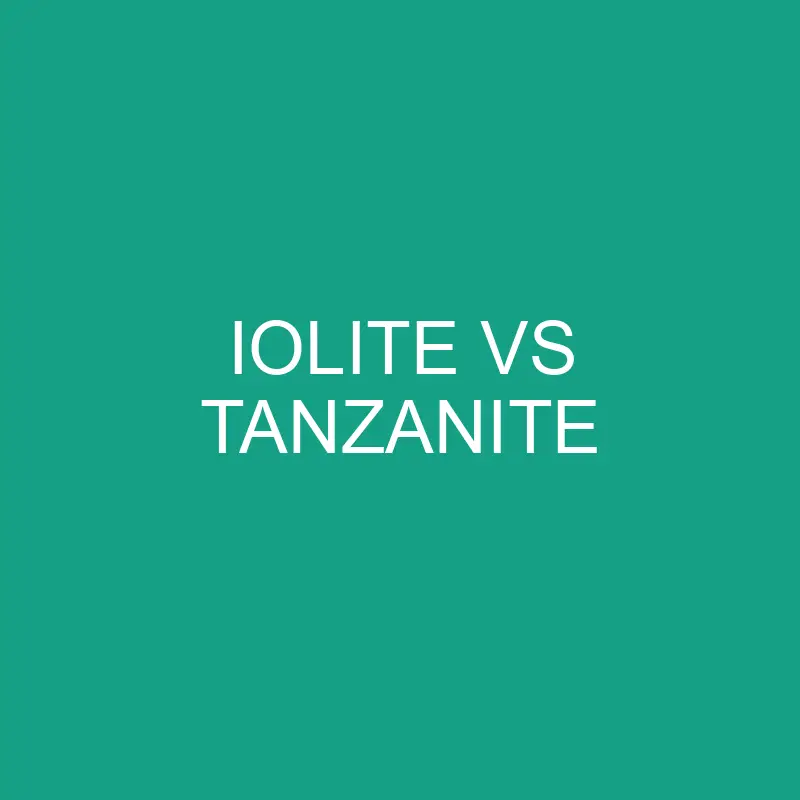Gemstones have long captured human fascination with their vibrant colors, unique properties, and cultural significance. Iolite and Tanzanite, while distinct in their characteristics, share a captivating allure that has made them sought-after gems in the world of jewelry and beyond. In this exploration, we’ll delve into the origins, physical properties, uses, and symbolic meanings of Iolite and Tanzanite to appreciate the individual charm each gem brings to the realm of precious stones.
Post Contents
Iolite: The Viking Compass Stone
Origins and Geological Background:
- Composition: Iolite is a gem variety of the mineral cordierite. It is an aluminum iron cyclosilicate.
- Color: Iolite is known for its striking blue to violet hues, often displaying pleochroism—showing different colors from different angles.
- Formation: Iolite is formed in metamorphic rocks and is often associated with regions rich in mica and other aluminum-bearing minerals.
Physical Properties:
- Color and Appearance: The color of Iolite can range from pale blue to deep violet. Its pleochroic nature makes it exhibit different colors depending on the viewing angle.
- Transparency: Iolite is typically transparent to translucent.
- Crystal Structure: It belongs to the orthorhombic crystal system.
- Luster: Iolite has a vitreous luster.
- Hardness: It has a hardness of 7-7.5 on the Mohs scale.
Origins and Mining:
- Locations: Iolite is found in various locations, including India, Brazil, Sri Lanka, and the United States.
- Mining: Extracted from metamorphic rocks, Iolite is obtained through traditional mining methods.
Metaphysical Properties:
- Viking Compass Stone: Iolite has earned the nickname “Viking Compass Stone” due to its historical use by Viking explorers. It is believed that they used thin slices of Iolite to reduce glare and determine the exact position of the sun on overcast days.
- Inner Journey: In metaphysical traditions, Iolite is associated with inner journeying, intuition, and self-discovery.
- Third Eye Chakra: It is thought to stimulate the third eye chakra, enhancing vision, both physically and intuitively.
Uses in Jewelry and Art:
- Jewelry: Iolite is commonly used in various jewelry pieces, including rings, necklaces, and earrings. Its pleochroic nature adds an element of intrigue to jewelry designs.
- Carvings and Decor: Iolite has been used in carvings and ornamental objects, displaying its captivating color variations.
Tanzanite: The Blue Beauty from Tanzania
Origins and Geological Background:
- Composition: Tanzanite is a blue variety of the mineral zoisite, and its striking blue color is attributed to the presence of vanadium.
- Color: Tanzanite is renowned for its intense blue and violet hues, often exhibiting trichroism—showing different colors in different crystal directions.
- Formation: Tanzanite is formed in metamorphic rocks, and its unique color is a result of heat treatment.
Physical Properties:
- Color and Appearance: Tanzanite ranges from blue to violet, and its trichroic nature means it can display blue, violet, and reddish-brown colors depending on the crystal’s orientation.
- Transparency: It is typically transparent.
- Crystal Structure: Tanzanite belongs to the orthorhombic crystal system.
- Luster: Tanzanite exhibits a vitreous to subadamantine luster.
- Hardness: It has a hardness of 6.5-7 on the Mohs scale.
Origins and Mining:
- Locations: Tanzanite is found only in a small area near Mount Kilimanjaro in Tanzania, East Africa.
- Mining: Tanzanite is obtained through traditional mining methods, and heat treatment is often applied to enhance its color.
Metaphysical Properties:
- Spiritual Enlightenment: Tanzanite is associated with spiritual enlightenment, transformation, and psychic abilities.
- Third Eye and Throat Chakras: It is believed to stimulate and balance the third eye and throat chakras, facilitating communication and intuition.
Uses in Jewelry and Art:
- Jewelry: Tanzanite is highly prized in jewelry, especially in rings, pendants, and earrings. Its vivid blue and violet hues make it a popular choice for both contemporary and traditional designs.
- Investment Pieces: High-quality, untreated Tanzanite is considered a valuable investment, and its rarity adds to its desirability.
Comparative Analysis: Iolite vs. Tanzanite
Color and Appearance:
- Iolite: Blue to violet, pleochroic.
- Tanzanite: Intense blue to violet, trichroic.
Transparency:
- Iolite: Transparent to translucent.
- Tanzanite: Typically transparent.
Crystal Structure:
- Iolite: Orthorhombic crystal system.
- Tanzanite: Orthorhombic crystal system.
Luster:
- Iolite: Vitreous luster.
- Tanzanite: Vitreous to subadamantine luster.
Hardness (Mohs Scale):
- Iolite: 7-7.5.
- Tanzanite: 6.5-7.
Origins and Mining:
- Iolite: Found in various locations globally. Mined from metamorphic rocks.
- Tanzanite: Exclusively found in Tanzania, East Africa. Mined from metamorphic rocks, often treated for color enhancement.
Metaphysical Properties:
- Iolite: Associated with inner journeying, intuition, and the third eye chakra.
- Tanzanite: Linked to spiritual enlightenment, transformation, and balance of the third eye and throat chakras.
Uses in Jewelry and Art:
- Iolite: Used in various jewelry pieces and carvings. Historically used as the “Viking Compass Stone.”
- Tanzanite: Highly prized in jewelry, considered an investment. Sought after for its unique color.
Conclusion: Iolite vs. Tanzanite
In the realm of gemstones, Iolite and Tanzanite each bring a distinctive charm that appeals to collectors, jewelry enthusiasts, and those who appreciate the metaphysical properties of gemstones. Iolite’s pleochroism and historical significance as the Viking Compass Stone give it a unique allure, while Tanzanite’s intense blue and violet hues, rarity, and association with spiritual enlightenment make it a prized gem.
Choosing between Iolite and Tanzanite may depend on personal preferences, the desired color palette, and the specific metaphysical properties one seeks. Whether adorned in the soothing blues of Iolite or the vibrant hues of Tanzanite, both gemstones contribute to the rich tapestry of the mineral kingdom, captivating hearts with their beauty and resonance.
